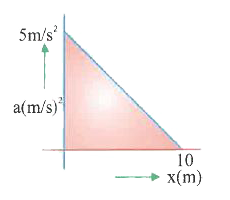An elevator cab of mass m=500 kg is descending with speed vi=4.0m/s when its supporting cable begins to slip, allowing it to fall with constant acceleration →a=→g/5 (Fig. 8-11a).
(c) What is the net work W done on the cab during the fall?
Calculation: The net work is the sum of the works done by the forces acting on the cab:
W=Wg+WT=5.88×104J−4.70×104J
=1.18×104J≈12kJ.
Topper's Solved these Questions
- WORK, POWER, AND ENERGYBOOK - RESNICK AND HALLIDAYCHAPTER - WORK, POWER, AND ENERGYEXERCISE - CHECKPOINT
6 Videos
- WORK, POWER, AND ENERGYBOOK - RESNICK AND HALLIDAYCHAPTER - WORK, POWER, AND ENERGYEXERCISE - PROBLEMS
58 Videos
- WAVES-IBOOK - RESNICK AND HALLIDAYCHAPTER - WAVES-IEXERCISE - Practice Questions (Integer Type)
4 Videos
Similar Questions
An elevator cab of mass m=500 kg is descending with speed vi=4.0m/s when its supporting cable begins to slip, allowing it to fall with constant acceleration →a=→g/5 (Fig. 8-11a).
(b) During the 12 m fall, what is the work WT done on the cab by the upward pull →T of hte elevator cable?
View SolutionAn elevator cab of mass m=500 kg is descending with speed vi=4.0m/s when its supporting cable begins to slip, allowing it to fall with constant acceleration →a=→g/5.
What is the cab's kinetic energy at the end of the 12 m fall ?
View Solution
Knowledge Check
A particle of mass 1 kg is moving in straight line and its acceleration v/s displacement graph is shown in figure. Work done by the force during x = 0 to x = 10 m is
 A25 JB26 JC28 JD30 J
A25 JB26 JC28 JD30 JAn elevator is moving upward with a speed of 11 m/s. Three seconds later, the elevator is still moving upward, but its speed has been reduced to 5.0 m/s. What is the average acceleration of the elevator during the 3.0 s interval ?
AThe particle remains at rest after t=3.0 s.BThe particle no longer accelerates after =3.0 s.CThe particle can be found at positions x<0 m only when t<0 s.DNone of the above is correct .
An elevator cab of mass m=500 kg is descending with speed vi=4.0m/s when its supporting cable begins to slip, allowing it to fall with constant acceleration →a=→g/5.
During the fall through a distance d=12 m, what is the work Wg done on the cab by the gravitational force →Fg?
View SolutionA body of mass m kg is ascending on a smooth inclined plane of inclination θ(sinθ=1x) with constant acceleration of a m/s2. The final velocity of the body is v m/s2. The work done by the body during this motion is (Initial velocity of the body = 0)
View SolutionAn elevator cab is pulled upward by a cable. The cab and its single occupant have a combined mass of 2000 kg. When that occupant drops a coin, its acceleration relative to the cab is 8.30 m/s2 downward. What is the tension in the cable?
View SolutionA particle of mass 0.5kg travels in a straight line with velocity v=ax3/2 where a=5m−1/2s−1. What is the work done by the net force during its displacement from x=0 to x=2m?
View SolutionA particle of mass 0.5kg travels in a straight line with velocity v=ax3/2 where a=5m−1/2s−1. What is the work done by the net force during its displacement from x=0 to x=2m?
View SolutionA particle of mass 0.5kg travels in a straight line with velocity v=ax3/2 where a=5m−1/2s−1. What is the work done by the net force during its displacement from x=0 to x=2m?
View Solution
